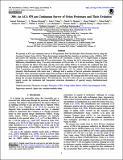Por favor, use este identificador para citar o enlazar a este item:
http://hdl.handle.net/10261/310298COMPARTIR / EXPORTAR:
 SHARE SHARE
 CORE
BASE CORE
BASE
|
|
| Visualizar otros formatos: MARC | Dublin Core | RDF | ORE | MODS | METS | DIDL | DATACITE | |

| Título: | 300: An ACA 870 μm Continuum Survey of Orion Protostars and Their Evolution |
Autor: | Federman, Samuel; Megeath, S. Thomas; Tobin, John J.; Sheehan, Patrick D.; Pokhrel, Riwaj; Habel, Nolan; Stutz, Amelia M.; Fischer, William J.; Hartmann, Lee; Stanke, Thomas; Narang, Mayank; Osorio, Mayra CSIC ORCID; Atnagulov, Prabhani; Rahatgaonkar, Rohan | Fecha de publicación: | 13-feb-2023 | Editor: | IOP Publishing | Citación: | Astrophysical Journal 944(1): 49 (2023) | Resumen: | We present an 870 μm continuum survey of 300 protostars from the Herschel Orion Protostar Survey using the Atacama Compact Array (ACA). These data measure protostellar flux densities on envelope scales ≤8000 au (20'') and resolve the structure of envelopes with 1600 au (4'') resolution, a factor of 3–5 improvement in angular resolution over existing single-dish 870 μm observations. We compare the ACA observations to Atacama Large Millimeter/submillimeter Array 12 m array observations at 870 μm with ∼0farcs1 (40 au) resolution. Using the 12 m data to measure the fluxes from disks and the ACA data within 2500 au to measure the combined disk plus envelope fluxes, we calculate the 12 m/ACA 870 μm flux ratios. Our sample shows a clear evolution in this ratio. Class 0 protostars are mostly envelope-dominated with ratios <0.5. In contrast, Flat Spectrum protostars are primarily disk-dominated with ratios near 1, although with a number of face-on protostars dominated by their envelopes. Class I protostars span the range from envelope to disk-dominated. The increase in ratio is accompanied by a decrease in the envelope fluxes and estimated mass infall rates. We estimate that 80% of the mass is accreted during the envelope-dominated phase. We find that the 12 m/ACA flux ratio is an evolutionary indicator that largely avoids the inclination and foreground extinction dependence of spectral energy distribution-based indicators. © 2023. The Author(s). Published by the American Astronomical Society. | Descripción: | This is an Open Access article distributed under the terms of the Creative Commons Attribution License (http://creativecommons.org/licenses/by/4.0/), which permits unrestricted reuse, distribution, and reproduction in any medium, provided the original work is properly cited. | Versión del editor: | http://dx.doi.org/10.3847/1538-4357/ac9f4b | URI: | http://hdl.handle.net/10261/310298 | DOI: | 10.3847/1538-4357/ac9f4b | ISSN: | 0004-637X | E-ISSN: | 1538-4357 |
| Aparece en las colecciones: | (IAA) Artículos |
Ficheros en este ítem:
| Fichero | Descripción | Tamaño | Formato | |
|---|---|---|---|---|
| 2023ApJ...944...49F.pdf | 2,89 MB | Adobe PDF |  Visualizar/Abrir |
CORE Recommender
SCOPUSTM
Citations
5
checked on 17-may-2024
WEB OF SCIENCETM
Citations
2
checked on 20-feb-2024
Page view(s)
33
checked on 22-may-2024
Download(s)
15
checked on 22-may-2024
Google ScholarTM
Check
Altmetric
Altmetric
Este item está licenciado bajo una Licencia Creative Commons

